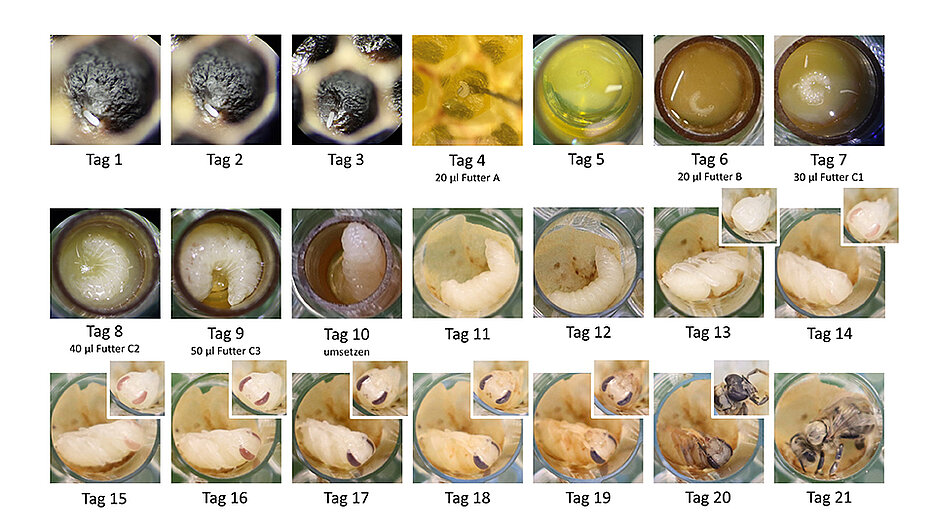Honeybees: Combinations of Pesticides Can be Dangerous
09/09/2024Dangerous mixtures: pesticides in combination can have unexpected effects on the development of honeybees. This is shown by a new study from the Biocenter.

Honeybees are social insects. Their colony only survives as a community, and healthy new generations are very important. It is therefore not surprising that honeybees invest significant care and resources into their offspring: nurse bees feed the young larvae with a food juice made from nectar and pollen which they produce in a gland in their head. However, pollen, in particular, can contain residues of various insecticides and other pesticides. It is therefore very likely that bee larvae are exposed to a complex mixture of chemicals.
What impact do insecticides authorised in the EU have on the development of honeybees, on their own and in combination with fungicides, especially in concentrations found in the environment? Researchers from the Biocenter of Julius-Maximilians-Universität (JMU) Würzburg in Bavaria, Germany, have investigated this question. Their findings have been published in the scientific journal Environmental Pollution.
The effects of pesticide combinations at low environmentally relevant doses have otherwise been rarely investigated. "As our study shows, this is urgently needed because the agents can interact and reinforce each other's effects," explains PhD student Sarah Manzer, first author of the study. It is also possible that interactions occur at low concentrations only and not at high concentrations, and vice versa. "There are large knowledge gaps which we have now been able to reduce with another piece of the puzzle," says the JMU researcher.
The Experiments: Feeding the Bee Larvae
The researchers reared honeybees in the laboratory and mixed various pesticides into their food –in concentrations that occur in the environment and in ten times higher doses.
The JMU team fed the honeybee larvae with the last neonicotinoid still authorised in the EU, acetamiprid – an insecticide used against the oilseed rape beetle and other sucking insects. All other neonicotinoids, which have been previously used, are now banned because they proofed to be harmful to bees. The researchers also fed a mixture of the fungicides boscalid and dimoxystrobin to the honeybee larvae as well as a combination of the neonicotinoid and the two fungicides.
The higher concentration of the neonicotinoid alone led to a significantly higher mortality of the larvae: 90.4% survived in the control group and only 79.8% in the neonicotinoid group. Sarah Manzer was also able to determine negative long-term effects: adult honeybees that had ingested the neonicotinoid as larvae died significantly earlier than the bees in the control group. They reached a median age of 26 days, compared to 31 days of the control honeybees. In the environmentally relevant concentration, however, the neonicotinoid had no effect on survival rates.
If the larval food contained the two fungicides only, no effect on the mortality of the insects was detected. However, the bees were lighter after hatching from the pupal stage than those in the control group. Further research will have to show whether this is relevant for their further development and behaviour.
Neonicotinoid Shows Complex Mixed Toxicity with Fungicides
The researchers were surprised when they fed the larvae with mixtures of the chemicals: the lower neonicotinoid dosage in combination with the fungicides led to a significantly increased mortality of the adult bees with a median age of 27 days compared to the age of 31 days for the bees in the control group. The otherwise harmless amount of neonicotinoid thus becomes dangerous in combination with the fungicides. "This is an alarming finding, as honeybees come into contact with many different pesticides due to their large flight radius," says Sarah Manzer.
And another unexpected effect occurred after feeding with the mixture: the higher neonicotinoid dosage – which had harmful effects on its own – showed no effect on bee mortality when combined with the fungicides.
Solitary Wild Bees May be More Affected
The combined effects found by the researchers could have an impact on the entire bee colony as their next generation could be harmed. In addition, solitary wild bees could be particularly affected due to the more direct pesticide effects, whereas honeybees in their large colonies could buffer the effects of pesticides to a certain extent.
According to the Würzburg scientists, further experiments are crucial to gain an even better understanding of the effects of pesticide mixtures.
Project in the Bavarian BayÖkotox Network
The study took place at the JMU Biocenter in cooperation between the groups of Professor Ricarda Scheiner (Zoology II) and Professor Ingolf Steffan-Dewenter (Zoology III) as part of the BayÖkotox project network. This network was designed and supported by the Bavarian State Ministry for the Environment and Consumer Protection across several universities. The objective of the project was to identify potential risks associated with the release of chemical products into the environment.
Publication
The neonicotinoid acetamiprid reduces larval and adult survival in honeybees (Apis mellifera) and interacts with a fungicide mixture. Sarah Manzer, Markus Thamm, Lioba Hilsmann, Beate Krischke, Ingolf Steffan-Dewenter, Ricarda Scheiner. Environmental Pollution, 2 August 2024, DOI: 10.1016/j.envpol.2024.124643, Open Access: https://www.sciencedirect.com/science/article/pii/S0269749124013575
Podcast
Here you will find an Podcast to the publication.
Contact
Sarah Manzer, Chair of Zoology II – Behavioral Physiology and Sociobiology, and Chair of Zoology III – Animal Ecology and Tropical Biology, University of Würzburg, T +49 931 31-87885, sarah.manzer@uni-wuerzburg.de






